The Russian Federation stretches from west to east and from north to south for many kilometers, so the zonality of the territory is clearly visible. The sun illuminates and heats different parts of the earth in different ways. Most heat falls on the equator, least of all - on the North and South Poles. A certain amount of heat, light, moisture enters different zones of the globe. These conditions define separate zones with their own special climate.
There are such natural zones: arctic deserts, tundra, forest-tundra, taiga, forests, forest-steppes, steppes, semi-deserts, deserts, subtropics.
A natural zone is a territory that is determined by uniform climatic conditions, features of the soil, vegetation and wildlife. The names of natural zones correspond to the name of the prevailing vegetation in this zone.
Arctic desert zone or ice zone
The Arctic desert zone is located in the very north of Russia, on the islands of the Arctic Ocean. Most of the territory of the zone (about 85%) is covered with glaciers. In the middle of summer, there is no more than 2-4 degrees of heat, and in winter it is frost down to -50 ° C, strong winds, fogs. The climate is very harsh.
The soils in this zone are very weak, there is no fertile layer, and there are many stone ruins. Only mosses and lichens grow on the rocks.
Reindeer, polar bears live in the Arctic desert, and sea birds settle on the rocky shores of the ocean: auks, gulls, polar owls and partridges. Baleen whales, seals, walruses, seals, white whales are found in the Arctic Ocean.
As humans invade, the Arctic wilderness is changing. Thus, industrial fishing has led to a reduction in their populations, which is one of the environmental problems of this zone. Every year the number of seals and walruses, polar bears and arctic foxes decreases here. Some species are on the verge of extinction due to human activities. In the zone of the Arctic deserts, scientists have identified significant reserves of minerals. Sometimes accidents occur during their extraction, and oil spills on the territory of ecosystems, harmful substances enter the atmosphere, and global pollution of the biosphere occurs. It is impossible not to touch on the topic of global warming. Human activity contributes to the melting of glaciers. As a result, the territories of the Arctic deserts are shrinking, the water level in the World Ocean is rising. This contributes not only to changes in ecosystems, but also to the movement of some species of flora and fauna to other areas and their partial extinction.
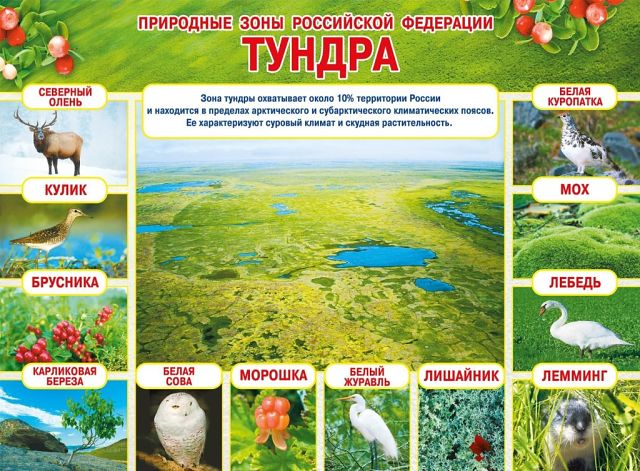
tundra zone
The Arctic tundra spreads along the coast of the Arctic Ocean. The climate of the tundra is harsh. In this cold natural zone, summers are short, cool, and winters are long, with severe frosts and winds from the Arctic Ocean.
Vegetation is sparse, mostly mosses and lichens. Further to the south, in the middle part of the zone, there is a lichen-moss tundra with islands of moss, lichens, among them reindeer moss and many cloudberries. In the south of the zone there is a shrub tundra with more abundant vegetation: shrub willows, dwarf birches, herbs and berries. Tundra soils are usually swampy, poor in humus, and have high acidity.
For the most part, there are no trees in the tundra. Low-growing plants cling to the ground, using its warmth and hiding from strong winds. Lack of heat, strong wind, lack of moisture for the root system do not allow the shoots to turn into large trees. In the south of the tundra zone, dwarf birches and shrub willows grow. In winter, the lack of food for animals is made up for by evergreens wintering under cover of snow.
Ducks, geese, black goose and sandpipers settle in the marshes. Herds of reindeer roam the tundra in search of reindeer moss - their main food. Deer, white partridges, owls, and crows constantly live in the tundra.
Forest-tundra zone
The forest tundra is a transitional zone from the harsh tundra to the forests of the taiga. The width of the forest-tundra ranges from 30 to 300 km in different regions of the country. The climate is warmer than in the tundra. In the forest-tundra, summers are warmer and the winds are weaker than in the tundra. Winter is cold, snowy lasts more than 9 months.
The soils of the forest-tundra are frozen-marsh, peaty-podzolic. These low fertile soils are low in humus and nutrients, with high acidity.
The flora of the tundra - meadows with willow bushes, sedge and horsetail grasses serve as a good pasture for deer. Due to the harsh climate, the islands of the forest are very sparse. In these forests - Siberian spruce, larch and birch.
Animals of the forest-tundra - wolves, arctic foxes. Geese, ducks, swans live on lakes and swamps in summer. In the summer in the forest-tundra there are a lot of blood-sucking horseflies and mosquitoes. Closer to the south, in the forest-tundra, there are squirrels, elk, brown bears, capercaillie.
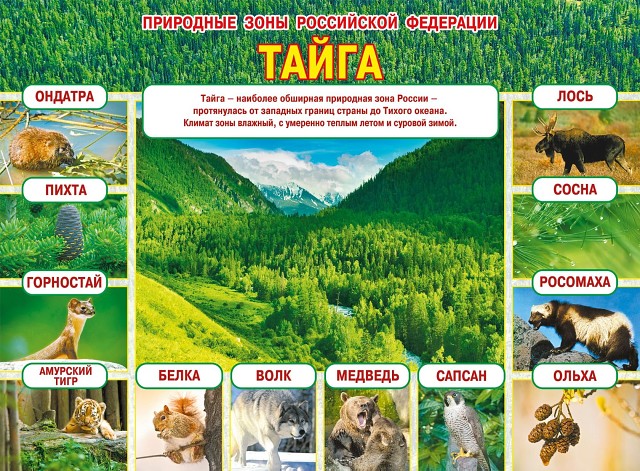
Taiga zone
Taiga is the largest natural zone in Russia, to the south of it there is a forest zone, or forest-steppe. Winter here is quite warm - 16-20 degrees of frost, in summer - 10 - 20 degrees of heat. There are significant natural differences within the zone, as it is located in two climatic zones - subarctic and temperate. The large rivers Ob, Yenisei and Lena flow from the south to the north of the zone.
The taiga is rich in swamps, lakes, groundwater. The amount of heat and moisture is sufficient for soil formation of fertile podzolic and marsh-podzolic soils.
Coniferous trees grow in the taiga - pines, spruces, fir, cedar and deciduous trees: birch, aspen, alder, larch. There are many meadows in the forests, there are swamps, many berries and mushrooms.
There are many different animals in the taiga - sable, capercaillie, hazel grouse, elk, squirrel. Brown bears, wolverines, lynxes are widespread. There are many blood-sucking insects in the taiga.
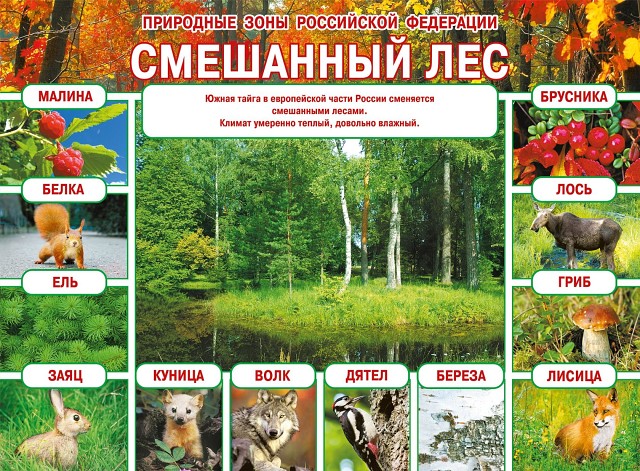
Zone of mixed and deciduous forests
To the south of the taiga, on the East European Plain and in the Far East, there is a forest zone. It has a lot of heat and moisture, many full-flowing rivers, lakes, and swamps are much smaller than in the taiga. Summers are long and warm (18-20 warm), winters are quite mild. There are large reserves of timber in this zone, and mineral deposits in the bowels of the earth.
The vegetation of the zone has been heavily modified by man, most of the territory is used for agriculture and cattle breeding.
Soils are formed by tree litter and are rich in ash elements. They have a top layer of fertile humus. The soils are soddy-podzolic, in the southern part - gray forest.
There are different trees in this zone: in the northern part, mixed forests with deciduous and coniferous trees: spruces, pines, birches, maples and aspens. Closer to the south, broad-leaved trees predominate: oak, elm, linden, maple. There are many shrubs in the forests: elderberry, raspberry; berries and mushrooms; abundance of herbs.
The availability of food throughout the year allows animals and most birds to live in the forest. There are many different animals in the forests: squirrels, owls, pine martens, elks, brown bears, foxes, and from birds - orioles, woodpeckers, etc.
forest-steppe
The forest-steppe zone is part of the temperate climate zone. This is a transitional zone between the forest zone and the steppe zone, combining forest belts and meadows covered with herbs. Flora and fauna represent plants and animals and forests and steppes. The closer to the south, the less forests, the less forest animals.
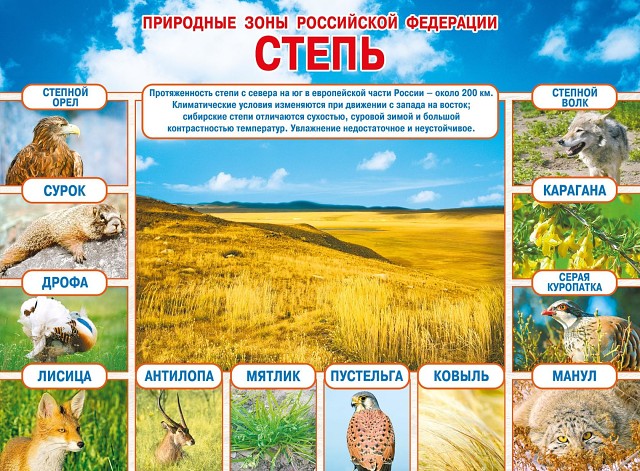
Steppe
The south of the forest-steppe passes into the steppe zone. The steppe zone is located on plains with grassy vegetation in a temperate and subtropical climate. In Russia, the steppe zone is located in the south near the Black Sea and in the valleys of the Ob River.
The soil in the steppe is fertile black soil. There are many arable lands and pastures for livestock. The climate of the steppes is characterized by very dry weather, hot summers, and lack of moisture. Winters in the steppe are cold and snowy.
The vegetation is mostly cereals growing in tufts with bare soil in between. There are many different types of feather grass that can serve as fodder for sheep.
In summer, animals are active mainly at night: jerboas, ground squirrels, marmots. Typical steppe birds: bustard, kestrel, steppe eagle, lark. Reptiles live in the steppe.
semi-deserts
The semi-desert zone is located in the southeast of the East European Plain, along the northwestern edge of the Caspian lowland.
A characteristic feature of semi-deserts is the dominance of wormwood-cereal plant communities. The vegetation cover is very sparse and does not have a continuous distribution: spots of drought-resistant soddy grasses and clumps of wormwood alternate with areas of bare soil.
The semi-deserts have a dry, sharply continental climate. This is due to the fact that cyclones are extremely rare here, and anticyclones come constantly from the depths of Eurasia. The annual amount of precipitation ranges from 250-400 mm, which is 2.5-3 times less than the evaporation rate. Despite the southern position, the winter in the semi-desert is cold. The average January temperature is from -5 to -8, and on some days the thermometer drops to -30. The average temperature in July is +20 - +25.
The soils of the semi-deserts are light chestnut, which makes them similar to the steppe, and brown soils are desert, often saline.
Despite the harsh climatic conditions, the flora in the deserts and semi-deserts of Russia is relatively diverse. Vegetation - steppe turf grasses and desert wormwood, shrubs and others
The fauna of semi-deserts has a number of features associated with specific living conditions. Many animals have devices for burrowing. Most are protective. Rodents play an important role in the fauna of the semi-deserts; their activity has led to the formation of a tubercular microrelief.
Many semi-deserts and deserts have significant reserves of oil and gas, as well as precious metals, which has led to the development of these territories by people. Oil production increases the level of danger, in the event of an oil spill, entire ecosystems are destroyed. But the main environmental problem is the expansion of desert territories. So many semi-deserts are transitional natural zones from steppes to deserts, but under the influence of certain factors they increase their territory and also turn into deserts. This process is most stimulated by anthropogenic activities - cutting down trees, exterminating animals (poaching), building industrial facilities, and depleting the soil. As a result, the semi-desert lacks moisture, plants die out, as do some animals, and some migrate. So the semi-desert quickly turns into a desert.
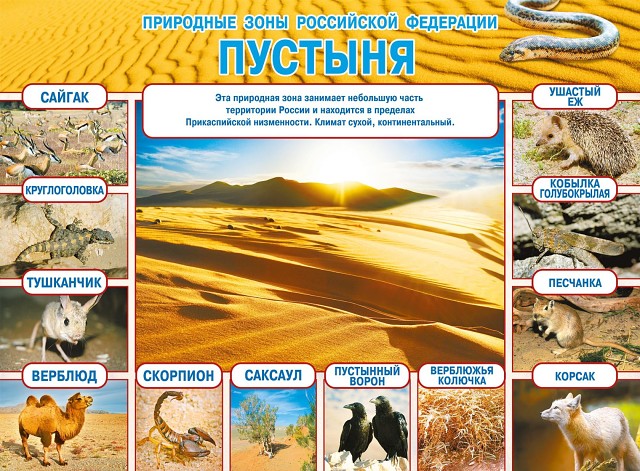
desert zone
Desert - a zone with a flat surface, sand dunes or clay and rocky surfaces. In Russia, there are deserts in the east of Kalmykia and in the south of the Astrakhan region.
The desert grows drought-resistant small shrubs, perennials that bloom and grow in early spring when there is moisture. Some herbaceous plants, after they wither, turn into balls of dry branches, they are called tumbleweeds. The wind drives them across the desert, scattering the seeds.
Hedgehogs, ground squirrels, jerboas, snakes, lizards live in deserts. Of the birds - larks, plovers, bustards.
The main ecological problem of deserts is their expansion due to irrational human activities. The problem of nuclear testing and disposal of nuclear waste is also on the list of environmental problems of the desert. Previously, many tests were carried out in deserts, which led to the problem of radioactive contamination. There is a problem of pollution by military waste. Various burials, military and nuclear, lead to groundwater pollution, the extinction of flora and fauna.
Today, desert and semi-desert territories are a specially protected natural zone in Russia. The desert and semi-desert are divided into special reserves, such as Astrakhan, Bogdinsko-Baskunchaksky and Caucasian, as well as reserves - Ilmenno-Bugrovaya, Stepnoy, Burley Sands and other protected areas.
Most of the plants and animals of the Russian desert were listed in the Red Book, and more than 35 natural monuments were created in the vast area of the Caspian lowland.
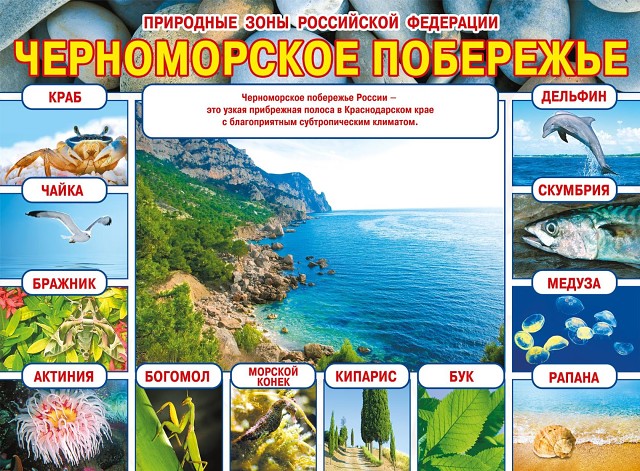
subtropical zone
In Russia, the territory of the subtropics is small - it is a narrow part of the coastal land near the Black Sea to the Caucasus Mountains. This zone has hot summers and mild winters. According to climatic conditions, the Russian subtropics are divided into dry and wet. From the southern coast of Crimea to the city of Gelendzhik - dry subtropics. Summers are dry, and only drought-resistant plants survive: prickly blackberries and wild roses. Pitsunda pine grows here, shrubs: juniper, cherry plum. Further along the coast, the amount of precipitation increases in summer, and from Gelendzhik to the border with Georgia, including the Sochi region, these are humid subtropics. The flora is very diverse and rich.
The mountains are covered with a dense green carpet of trees and shrubs. There are broad-leaved trees - oaks, beech chestnuts, coniferous yew is remarkable, evergreen shrubs grow: laurel, rhododendron and boxwood.
In the forests near Sochi you can meet bears, wolves, forest cats, badgers, jackals. There are many rodents in the forests - squirrels, mice, there are snakes. There are many shellfish on the coast: snails, slugs. Birds settle in the mountains - kites, eagles, owls.
On the map, each natural zone is usually designated by its own color:
Arctic deserts - blue, light purple.
Tundra is purple.
Forest tundra - marsh.
Taiga, forests - different shades of green.
Forest-steppe - yellow-green.
Steppes - yellow.
Semi-deserts and deserts - orange.
Areas of high zonation are brown.
It is sad to realize, but even a slight intervention of people in the life of the natural world always leads to some changes in it, and, moreover, not always to favorable ones. Deforestation, destruction of animals (poaching), environmental pollution are the main environmental problems that exist in Russia, regardless of the climatic zone. And a lot depends on the person in changing the deplorable environmental situation for the better.
